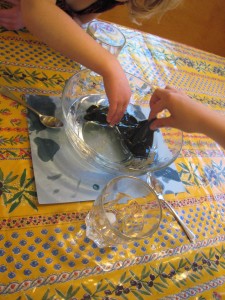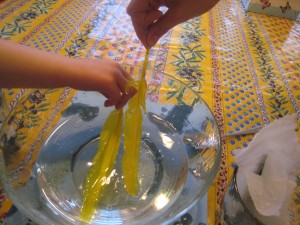Tag: spill’
Oil Spill Experiment Revisited
- by KitchenPantryScientist
I first posted this experiment on May 5, certain that the spill would soon be contained. Now we know it’s worse than we imagined and no immediate solution is in sight. If your kids don’t understand why it’s so hard to help the birds, have them try this project.
The oil spill in the Gulf of Mexico is devastating news to the already fragile and damaged ecosystems in the area. To demonstrate how hard it is to remove oil from water, and what materials work best, I found this experiment online at tryscience.org and decided to have my kids try it. It was messy and disgusting and oil got all over everything. In other words, it was a great demonstration of how hard it will be to clean up the mess made by BP’s Deepwater Horizen oil rig, which exploded on April 20th.
You’ll need a clear bowl, water, yellow oil (vegetable, corn or canola will work,) cotton balls, cheese cloth, polyester cloth (the website said polypropylene, but I couldn’t find any,) feathers, and a spoon.
Put some water in the bowl and pour in some oil. I probably added a cup so it would cover the water. Then, using spoons and the other materials, try to remove the oil from the water. What works best?
We put our feathers in oil and then tried to clean them off using dish soap and water, which is how they clean off marine birds covered with oil following oil spills.
Polypropylene is a synthetic material made from Carbon and Hydrogen, the same elements in oil. Oil is attracted to polypropylene, and both float on water, so polypropylene is often used in cleaning up oil spills. You can also find it in gloves and sock liners.
If one cup of oil is this hard to clean up, can you imagine the mess pouring into the Gulf of Mexico right now, at the rate of about 210,000 gallons a day (according to the New York Times.) Here is a link to a map that is tracking the spill.
Oil Spill Experiment
- by KitchenPantryScientist
The oil spill in the Gulf of Mexico is devastating news to the already fragile and damaged ecosystems in the area. To demonstrate how hard it is to remove oil from water, and what materials work best, I found this experiment online at tryscience.org and decided to have my kids try it. It was messy and disgusting and oil got all over everything. In other words, it was a great demonstration of how hard it will be to clean up the mess made by BP’s Deepwater Horizen oil rig, which exploded on April 20th.
You’ll need a clear bowl, water, yellow oil (vegetable, corn or canola will work,) cotton balls, cheese cloth, polyester cloth (the website said polypropylene, but I couldn’t find any,) feathers, and a spoon.
Put some water in the bowl and pour in some oil. I probably added a cup so it would cover the water. Then, using spoons and the other materials, try to remove the oil from the water. What works best?
We put our feathers in oil and then tried to clean them off using dish soap and water, which is how they clean off marine birds covered with oil following oil spills.
Polypropylene is a synthetic material made from Carbon and Hydrogen, the same elements in oil. Oil is attracted to polypropylene, and both float on water, so polypropylene is often used in cleaning up oil spills. You can also find it in gloves and sock liners.
If one cup of oil is this hard to clean up, can you imagine the mess pouring into the Gulf of Mexico right now, at the rate of about 210,000 gallons a day (according to the New York Times?) I’m attempting to find out if there’s any way to help, aside from travelling to the area to help clean off wildlife by hand. As soon as I learn anything, I’ll post it here! Here is a link to a map that is tracking the spill.

